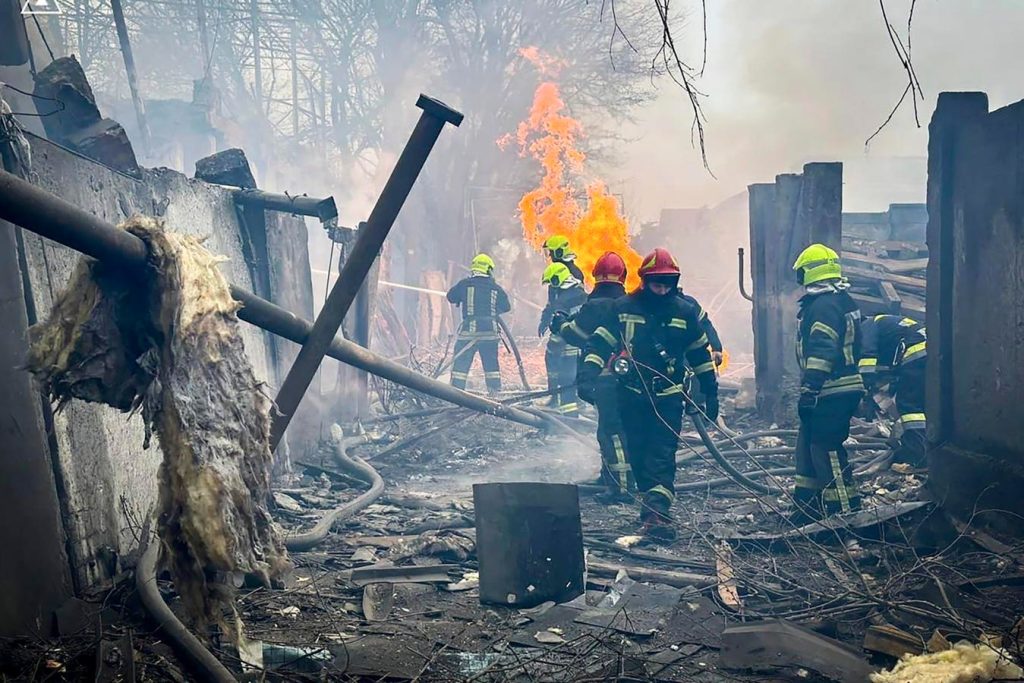Dispatches from Ukraine. Day 750
A Russian missile attack on the port city of Odesa on March 15 killed 20 people and wounded 73 others. The first missile struck at least 10 homes while the second targeted first responders, two of whom were among the dead. Russia’s attacks on Odessa in the past year have focused on the port in an attempt to disrupt shipping operations.
Russia’s shelling of Kryvyi Rih on March 12 claimed the lives of five people and wounded 44 others, including 10 children. Missiles struck residential high-rises, setting off fires to which more than 100 firefighters responded. “We will inflict losses on the Russian state in response – quite rightly,” Ukrainian President Volodymyr Zelenskyy responded to the attack. “They, in the Kremlin, must get used to the fact that terror does not go unpunished for them.” On March 15, Ukrainian drones set an oil refinery on fire in Russia’s Kaluga region.
Sumy. A large drone raid, also on March 12, damaged at least 20 units, some beyond repair. in an apartment building in the city of Sumy. Policemen and firefighters rescued 10 people from the rubble and discovered the bodies of three others.
Myrhohrad. In Myrnohrad, close to the front lines, a Russian missile attack on March 12 killed two civilians and wounded five others.
Kharkiv region. Russia attacked the village of Zolochiv in the Kharkiv region with S-300 missiles. Oleh Syniehubov, the head of the Kharkiv Regional Military Administration, said the attack destroyed the premises of a dormitory and an emergency medical center, as well as damaged the premises of the Zolochiv hospital.
Three groups of Russian defectors serving in Ukraine’s armed forces launched a cross-border raid towards Belgorod, home to several Russian military bases and training facilities, on March 12. Homes in the city have come under missile and drone attack, with several deaths reports. Although Russia claims that it has repelled the incursion, fighting continues in the area.
In line with Ukraine’s aim to ramp up domestic production of weapons and investment in combat equipment, the Ministry of Digital Transformation has announced the launch of mass manufacture of robotic ground platforms; more than 50 of these vital battlefield vehicles, designed to minimize the presence of humans on the battlefield, have already passed all field tests and are to be deployed in combat hot spots in the months to come. The vehicles include kamikaze platforms, turrets and platforms that can destroy Russian equipment while also mining, demining and evacuating casualties. “Ground-based robotic systems will become the next game changer in this war, as our drones already are,” said Minister Mykhailo Federov. “This is an asymmetric response to the enemy’s numerical superiority.”
Efforts promoting the evolution of Ukraine’s defenses are navigated through platforms such as Brave1, a tech cluster established to coordinate cooperation among defense tech companies, the government and the military, as well as investors, volunteer foundations and the media. According to Brave1’s roadmap, anyone from start-ups and private companies is welcome to submit ideas or projects and compete for a state grant. Recent publicly available figures show that more than 140 robotic systems have been registered via the Brave1 platform, 96 of them have already passed defense testing and 14 have been codified according to NATO standards. Some of these robots, such as the ShaBla turret, are already in service at the front.
Washington brings good news to Kyiv with the recent announcement of a $400 million arms package despite the “aid drought” stemming from party deadlocks in the U.S. corridors of power. The March 12 offering provides Ukraine with, above all, Stinger anti-aircraft missiles, ammunition, anti-tank grenade launchers and some maintenance equipment. “I am grateful to the American people and to U.S. Secretary of Defense Lloyd Austin personally for their unwavering support,” said Ukrainian Defense Minister Rustem Umerov. This package is the first U.S. aid for the Ukrainian army since December, 2023. Republicans in Congress, taking their cue from former President Donald Trump’s opposition to any such funding, have been blocking continued aid for Kyiv. According to a recent assessment by the Institute for the Study of War, the lack of arms due to the impasse in Washington has left Ukraine vulnerable to an imminent Russian breakthrough on the front lines.
Denmark has pledged to deliver its 16th security package to Ukraine. The new package, worth $350,000, will provide artillery and mortar systems sorely needed by Ukraine. “With this donation package, we are providing a substantial contribution to the Ukrainian freedom struggle in the form of both additional CAESAR artillery systems and accompanying ammunition,” said Danish Defense Minister Troels Poulsen. Denmark has set aside $3.7 billion in military support for Ukraine for the next four years.
By Daria Dzysiuk, Alan Sacks
Read the full article here















